2014 NISSAN QUEST headrest
[x] Cancel search: headrestPage 9 of 482
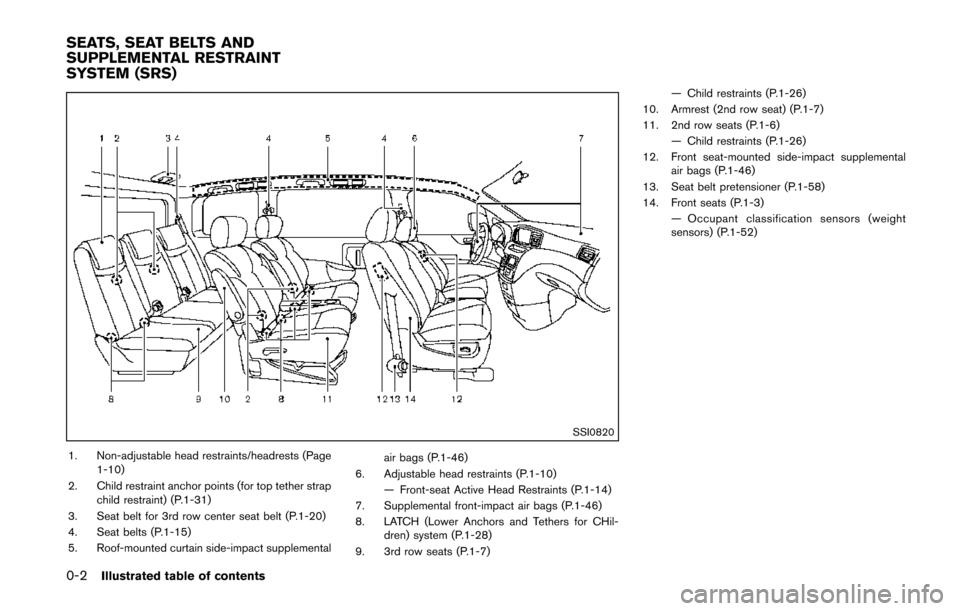
0-2Illustrated table of contents
SSI0820
1. Non-adjustable head restraints/headrests (Page1-10)
2. Child restraint anchor points (for top tether strap child restraint) (P.1-31)
3. Seat belt for 3rd row center seat belt (P.1-20)
4. Seat belts (P.1-15)
5. Roof-mounted curtain side-impact supplemental air bags (P.1-46)
6. Adjustable head restraints (P.1-10) — Front-seat Active Head Restraints (P.1-14)
7. Supplemental front-impact air bags (P.1-46)
8. LATCH (Lower Anchors and Tethers for CHil- dren) system (P.1-28)
9. 3rd row seats (P.1-7) — Child restraints (P.1-26)
10. Armrest (2nd row seat) (P.1-7)
11. 2nd row seats (P.1-6) — Child restraints (P.1-26)
12. Front seat-mounted side-impact supplemental air bags (P.1-46)
13. Seat belt pretensioner (P.1-58)
14. Front seats (P.1-3) — Occupant classification sensors (weight
sensors) (P.1-52)
SEATS, SEAT BELTS AND
SUPPLEMENTAL RESTRAINT
SYSTEM (SRS)
Page 18 of 482
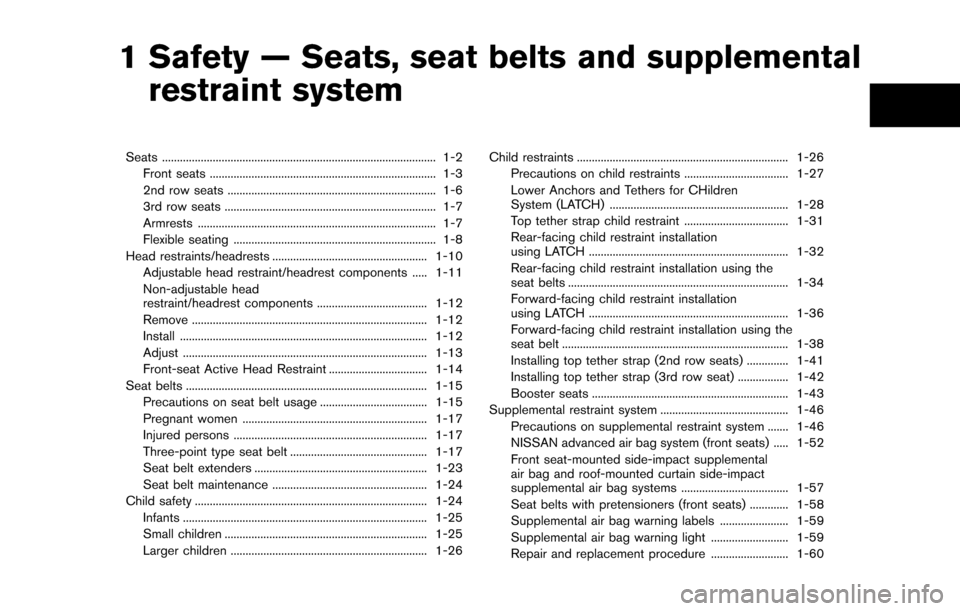
1 Safety — Seats, seat belts and supplementalrestraint system
Seats ........................................................................\
.................... 1-2
Front seats ........................................................................\
.... 1-3
2nd row seats ...................................................................... 1-6
3rd row seats ....................................................................... 1-7
Armrests ........................................................................\
........ 1-7
Flexible seating .................................................................... 1-8
Head restraints/headrests .................................................... 1-10 Adjustable head restraint/headrest components ..... 1-11
Non-adjustable head
restraint/headrest components ..................................... 1-12
Remove ........................................................................\
....... 1-12
Install ........................................................................\
........... 1-12
Adjust ........................................................................\
.......... 1-13
Front-seat Active Head Restraint ................................. 1-14
Seat belts ........................................................................\
......... 1-15 Precautions on seat belt usage .................................... 1-15
Pregnant women .............................................................. 1-17
Injured persons ................................................................. 1-17
Three-point type seat belt .............................................. 1-17
Seat belt extenders .......................................................... 1-23
Seat belt maintenance .................................................... 1-24
Child safety ........................................................................\
...... 1-24 Infants ........................................................................\
.......... 1-25
Small children .................................................................... 1-25
Larger children .................................................................. 1-26 Child restraints ....................................................................... 1-26
Precautions on child restraints ................................... 1-27
Lower Anchors and Tethers for CHildren
System (LATCH) ............................................................ 1-28
Top tether strap child restraint ................................... 1-31
Rear-facing child restraint installation
using LATCH ................................................................... 1-32
Rear-facing child restraint installation using the
seat belts ........................................................................\
.. 1-34
Forward-facing child restraint installation
using LATCH ................................................................... 1-36
Forward-facing child restraint installation using the
seat belt ........................................................................\
.... 1-38
Installing top tether strap (2nd row seats) .............. 1-41
Installing top tether strap (3rd row seat) ................. 1-42
Booster seats .................................................................. 1-43
Supplemental restraint system ........................................... 1-46 Precautions on supplemental restraint system ....... 1-46
NISSAN advanced air bag system (front seats) ..... 1-52
Front seat-mounted side-impact supplemental
air bag and roof-mounted curtain side-impact
supplemental air bag systems .................................... 1-57
Seat belts with pretensioners (front seats) ............. 1-58
Supplemental air bag warning labels ....................... 1-59
Supplemental air bag warning light .......................... 1-59
Repair and replacement procedure .......................... 1-60
Page 25 of 482
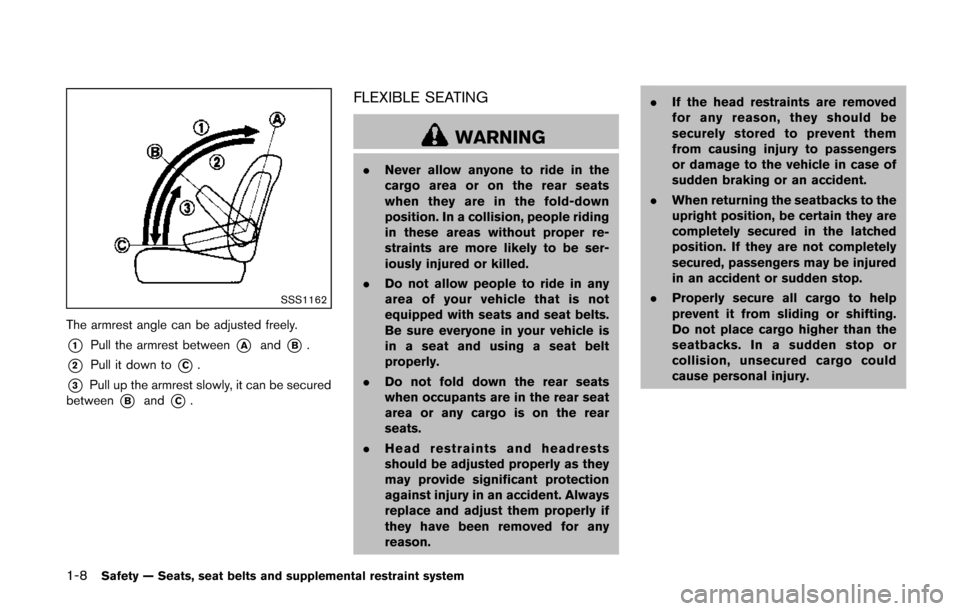
1-8Safety — Seats, seat belts and supplemental restraint system
SSS1162
The armrest angle can be adjusted freely.
*1Pull the armrest between*Aand*B.
*2Pull it down to*C.
*3Pull up the armrest slowly, it can be secured
between
*Band*C.
FLEXIBLE SEATING
WARNING
. Never allow anyone to ride in the
cargo area or on the rear seats
when they are in the fold-down
position. In a collision, people riding
in these areas without proper re-
straints are more likely to be ser-
iously injured or killed.
. Do not allow people to ride in any
area of your vehicle that is not
equipped with seats and seat belts.
Be sure everyone in your vehicle is
in a seat and using a seat belt
properly.
. Do not fold down the rear seats
when occupants are in the rear seat
area or any cargo is on the rear
seats.
. Head restraints and headrests
should be adjusted properly as they
may provide significant protection
against injury in an accident. Always
replace and adjust them properly if
they have been removed for any
reason. .
If the head restraints are removed
for any reason, they should be
securely stored to prevent them
from causing injury to passengers
or damage to the vehicle in case of
sudden braking or an accident.
. When returning the seatbacks to the
upright position, be certain they are
completely secured in the latched
position. If they are not completely
secured, passengers may be injured
in an accident or sudden stop.
. Properly secure all cargo to help
prevent it from sliding or shifting.
Do not place cargo higher than the
seatbacks. In a sudden stop or
collision, unsecured cargo could
cause personal injury.
Page 27 of 482
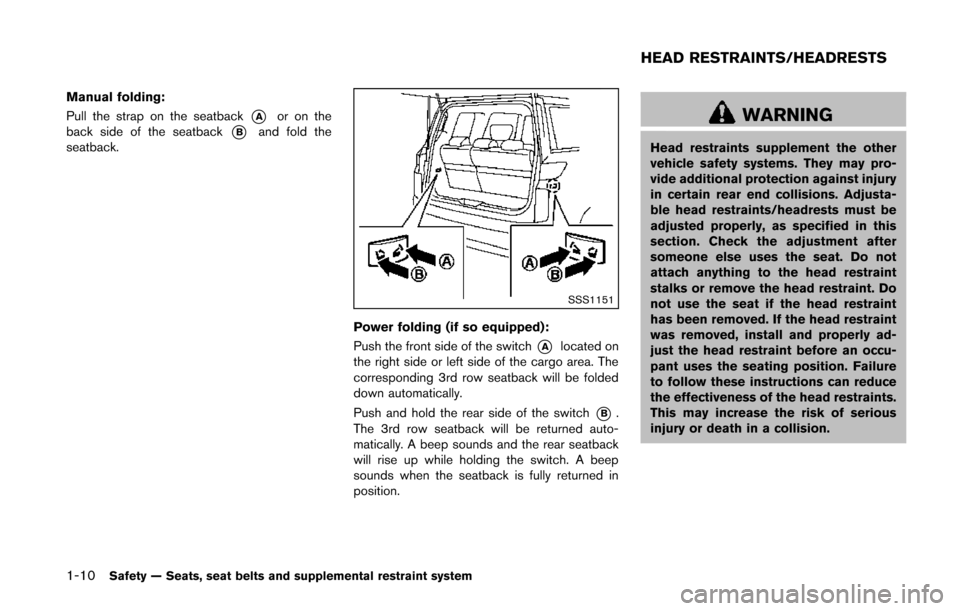
1-10Safety — Seats, seat belts and supplemental restraint system
Manual folding:
Pull the strap on the seatback
*Aor on the
back side of the seatback
*Band fold the
seatback.
SSS1151
Power folding (if so equipped):
Push the front side of the switch
*Alocated on
the right side or left side of the cargo area. The
corresponding 3rd row seatback will be folded
down automatically.
Push and hold the rear side of the switch
*B.
The 3rd row seatback will be returned auto-
matically. A beep sounds and the rear seatback
will rise up while holding the switch. A beep
sounds when the seatback is fully returned in
position.
WARNING
Head restraints supplement the other
vehicle safety systems. They may pro-
vide additional protection against injury
in certain rear end collisions. Adjusta-
ble head restraints/headrests must be
adjusted properly, as specified in this
section. Check the adjustment after
someone else uses the seat. Do not
attach anything to the head restraint
stalks or remove the head restraint. Do
not use the seat if the head restraint
has been removed. If the head restraint
was removed, install and properly ad-
just the head restraint before an occu-
pant uses the seating position. Failure
to follow these instructions can reduce
the effectiveness of the head restraints.
This may increase the risk of serious
injury or death in a collision.
HEAD RESTRAINTS/HEADRESTS
Page 28 of 482
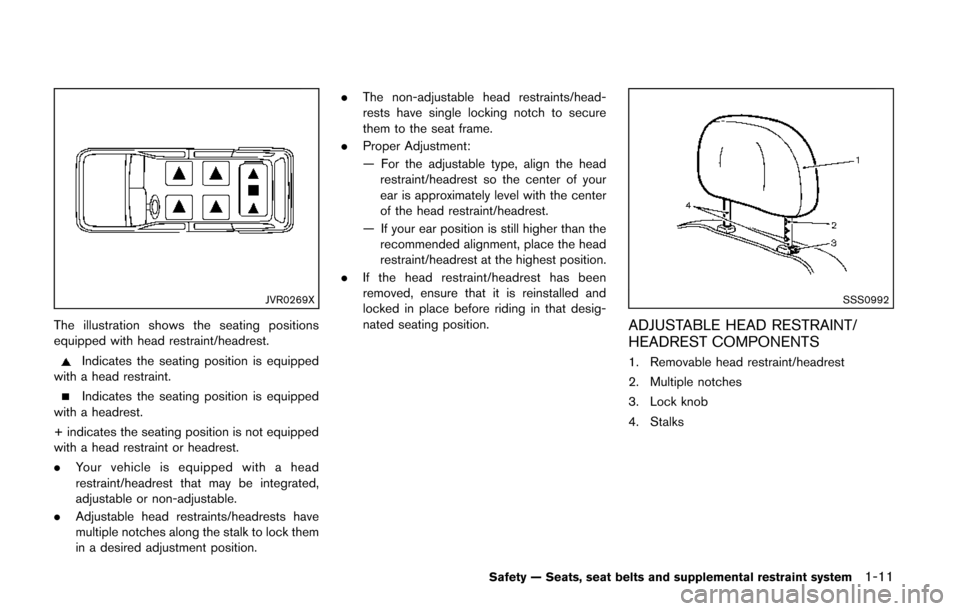
JVR0269X
The illustration shows the seating positions
equipped with head restraint/headrest.
Indicates the seating position is equipped
with a head restraint.
Indicates the seating position is equipped
with a headrest.
+ indicates the seating position is not equipped
with a head restraint or headrest.
. Your vehicle is equipped with a head
restraint/headrest that may be integrated,
adjustable or non-adjustable.
. Adjustable head restraints/headrests have
multiple notches along the stalk to lock them
in a desired adjustment position. .
The non-adjustable head restraints/head-
rests have single locking notch to secure
them to the seat frame.
. Proper Adjustment:
— For the adjustable type, align the head
restraint/headrest so the center of your
ear is approximately level with the center
of the head restraint/headrest.
— If your ear position is still higher than the recommended alignment, place the head
restraint/headrest at the highest position.
. If the head restraint/headrest has been
removed, ensure that it is reinstalled and
locked in place before riding in that desig-
nated seating position.
SSS0992
ADJUSTABLE HEAD RESTRAINT/
HEADREST COMPONENTS
1. Removable head restraint/headrest
2. Multiple notches
3. Lock knob
4. Stalks
Safety — Seats, seat belts and supplemental restraint system1-11
Page 29 of 482
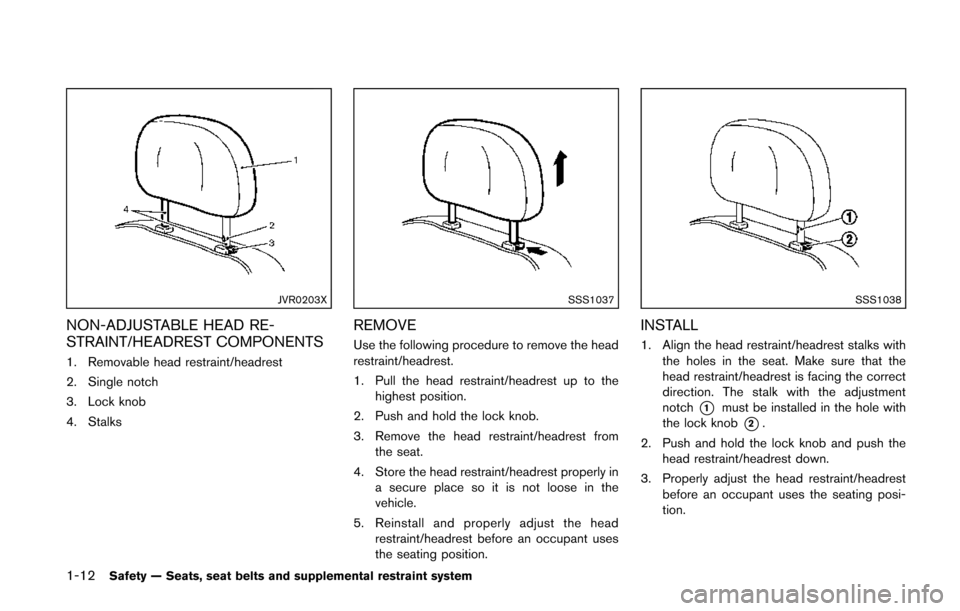
1-12Safety — Seats, seat belts and supplemental restraint system
JVR0203X
NON-ADJUSTABLE HEAD RE-
STRAINT/HEADREST COMPONENTS
1. Removable head restraint/headrest
2. Single notch
3. Lock knob
4. Stalks
SSS1037
REMOVE
Use the following procedure to remove the head
restraint/headrest.
1. Pull the head restraint/headrest up to thehighest position.
2. Push and hold the lock knob.
3. Remove the head restraint/headrest from the seat.
4. Store the head restraint/headrest properly in a secure place so it is not loose in the
vehicle.
5. Reinstall and properly adjust the head restraint/headrest before an occupant uses
the seating position.
SSS1038
INSTALL
1. Align the head restraint/headrest stalks with
the holes in the seat. Make sure that the
head restraint/headrest is facing the correct
direction. The stalk with the adjustment
notch
*1must be installed in the hole with
the lock knob
*2.
2. Push and hold the lock knob and push the head restraint/headrest down.
3. Properly adjust the head restraint/headrest before an occupant uses the seating posi-
tion.
Page 30 of 482
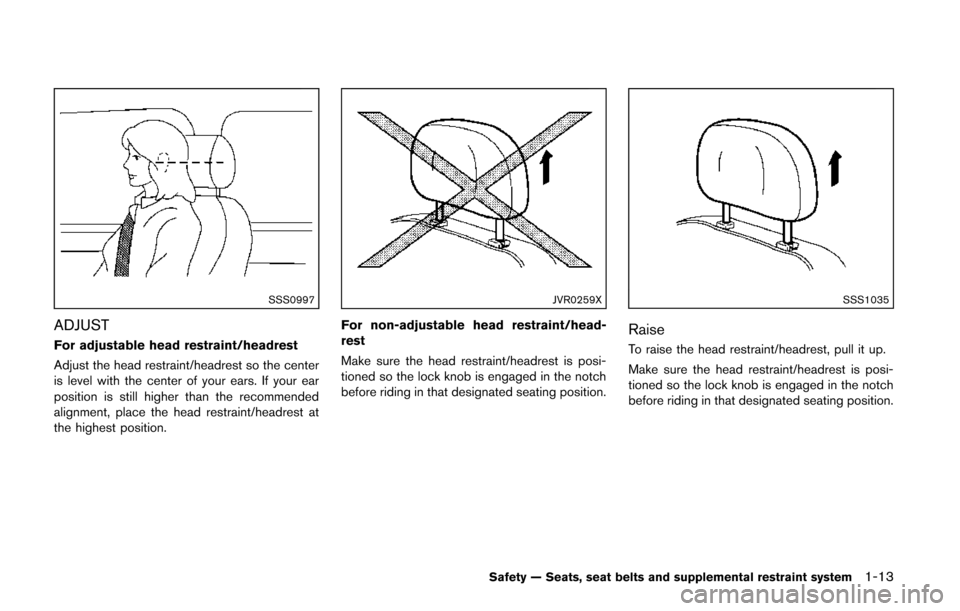
SSS0997
ADJUST
For adjustable head restraint/headrest
Adjust the head restraint/headrest so the center
is level with the center of your ears. If your ear
position is still higher than the recommended
alignment, place the head restraint/headrest at
the highest position.
JVR0259X
For non-adjustable head restraint/head-
rest
Make sure the head restraint/headrest is posi-
tioned so the lock knob is engaged in the notch
before riding in that designated seating position.
SSS1035
Raise
To raise the head restraint/headrest, pull it up.
Make sure the head restraint/headrest is posi-
tioned so the lock knob is engaged in the notch
before riding in that designated seating position.
Safety — Seats, seat belts and supplemental restraint system1-13
Page 31 of 482
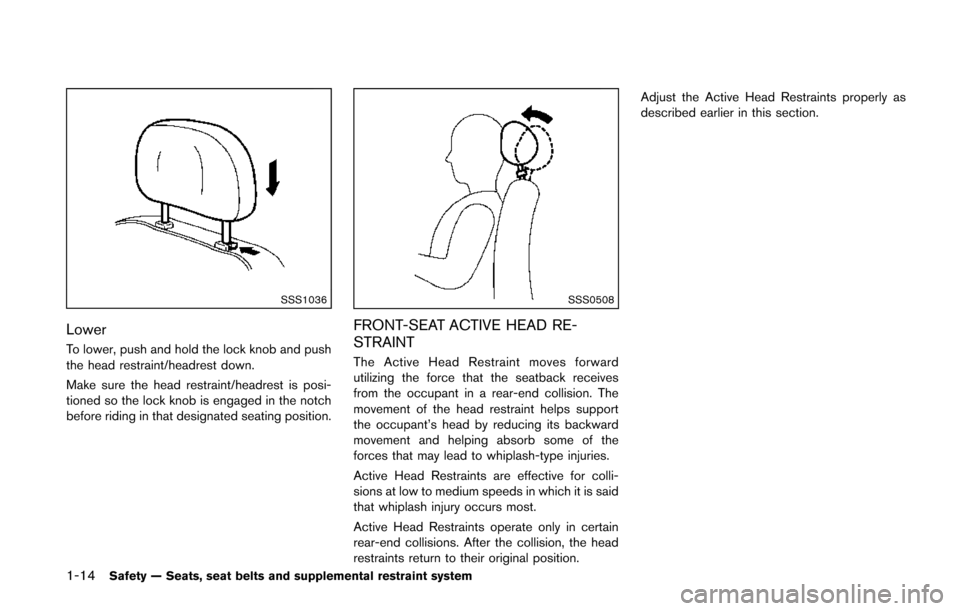
1-14Safety — Seats, seat belts and supplemental restraint system
SSS1036
Lower
To lower, push and hold the lock knob and push
the head restraint/headrest down.
Make sure the head restraint/headrest is posi-
tioned so the lock knob is engaged in the notch
before riding in that designated seating position.
SSS0508
FRONT-SEAT ACTIVE HEAD RE-
STRAINT
The Active Head Restraint moves forward
utilizing the force that the seatback receives
from the occupant in a rear-end collision. The
movement of the head restraint helps support
the occupant’s head by reducing its backward
movement and helping absorb some of the
forces that may lead to whiplash-type injuries.
Active Head Restraints are effective for colli-
sions at low to medium speeds in which it is said
that whiplash injury occurs most.
Active Head Restraints operate only in certain
rear-end collisions. After the collision, the head
restraints return to their original position.Adjust the Active Head Restraints properly as
described earlier in this section.